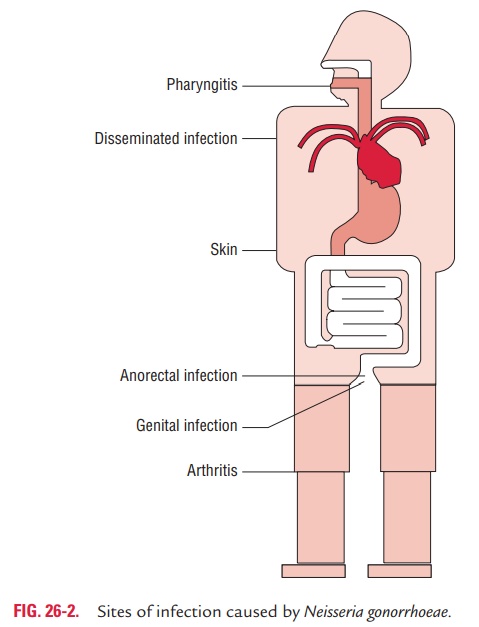Chapter: Microbiology and Immunology: Bacteriology: Neisseria
Clinical Syndromes - Neisseria gonorrhoeae
Clinical Syndromes
N. gonorrhoeae cause following clinical syndromes (Fig. 26-2):(a) gonorrhea, (b) disseminated gonococcal infections (DGI), (c) ophthalmia neonatorum, and (d) other gonococcal diseases.

◗ Gonorrhea
Gonorrhea is a sexually transmitted disease. It is primarily a genital infection restricted to the urethra in men and cervix in women. The incubation period varies from 2 to 8 days.
Gonorrhea in men: A symptomatic acute infection is seen inapproximately 95% of all infected men. Urethritis is the major clinical manifestation, with burning micturition and serous urethral discharge as the initial manifestation. Subsequently, the discharge becomes more profuse, purulent, and even blood-tinged. Acute epididymitis, prostatitis, and periurethral abscess are rare, but are noted gonococcal complications in men.
Gonorrhea in women: In women, endocervix is the primarysite (80–90%) of infection because gonococci invade only the endocervical columnar epithelial cells. The bacteria cannot infect the squamous epithelial cells in the vagina of postpu-bescent women. Urethra (80%), rectum (40%), and pharynx (10–20%) are the other sites of infection in women. The infec-tion is mostly asymptomatic in women. The presence of vagi-nal discharge, dysuria, dyspareunia, and mild lower abdominal pain are the common symptoms in symptomatic women. In 10–20% of infected women, the primary infection may spread from urethra and cervix to cause ascending genital infections including salpingitis, tubo-ovarian abscess, and pelvic inflam-matory disease (PID).
· Pelvic inflammatory disease (PID) is the most importantcomplication in females following gonococcal infection. Increased vaginal discharge or purulent urethral discharge, dysuria, lower abdominal pain, and intermenstrual bleeding are the common symptoms of the PID. Tubal scarring, ecto-pic pregnancy, and infertility are the major complications in women following PID.
· Gonococcal vulvovaginitis occurs in prepubertal girls throughsexual contact.
◗ Disseminated gonococcal infections
Disseminated gonococcal infection (DGI) occurs because of hematogenous dissemination of gonococci from the primary site of infection. The symptoms vary greatly from patient to patient. Arthritis-dermatitis syndrome is the classic presenta-tion of DGI. Joint or tendon pain is most common in the early stage of infection. Migratory polyarthralgia, especially of the knees, elbows, and more distal joints, and also tenosynovitis are the common symptoms. The skin lesions include maculopapu-lar to pustular lesions often with a hemorrhagic component. Septic arthritis, especially of the knee, is the next stage of DGI. During this stage, skin lesions usually disappear and blood cul-tures for gonococci are always negative. The DGI is mostly seen in untreated asymptomatic women and in persons with comple-ment deficiency.
◗ Ophthalmia neonatorum
Ophthalmia neonatorum is a nonsexually transmitted infec-tion caused by N. gonorrhoeae. This is a condition of bilateral conjunctivitis of a neonate born by vaginal delivery to an infected mother. However, transmission to the newborn can also occur in utero or in the postpartum period. Pain in the eyes, redness, and purulent discharge are the common symptoms. Blindness is an important complication of this condition. Gonococci can cause permanent injury to the eye in a very short time; hence prompt recognition and treatment of the condi-tion are very essential to avoid blindness.
◗ Other gonococcal infections
These include the following:
· Anorectal gonorrhea and gonococcal pharyngitis occur in homosexual men following rectal intercourse or by oro-genital contact, respectively. Pharyngitis is most commonly acquired during orogenital contact. Pharyngitis often is asymptomatic, however, it may present as exudative pharyn-gitis with cervical lymphadenopathy.
· Purulent gonococcal conjunctivitis occurs in adults follow-ing autoinoculation of gonococci into the conjunctival sac from a primary site of infection, such as the genitals. The conjunctivitis may rapidly progress to panophthalmitis and loss of the eye unless promptly treated.
· Acute perihepatitis (Fitz–Hugh and Curtis syndrome) occurs due to the direct extension of N. gonorrhoeae orChlamydiatrachomatis from the fallopian tube to the liver capsule andoverlying peritoneum.
Related Topics